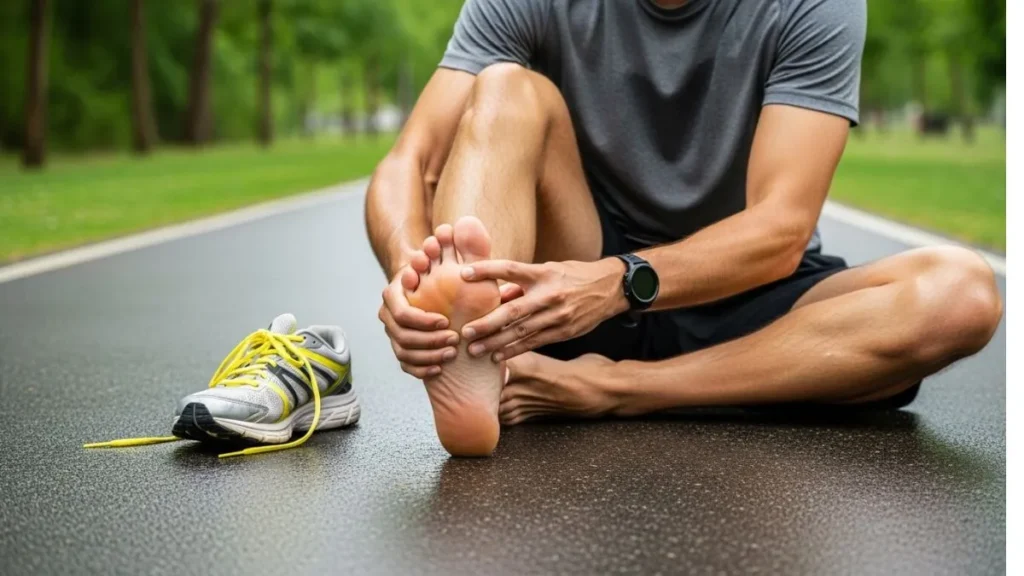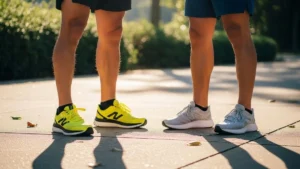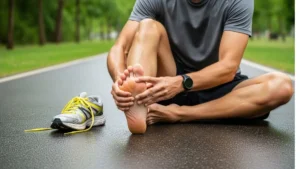
Introduction: Understanding Arch Pain After Running
Your arches hurt after running because the muscles and ligaments in your feet are under stress from repeated impact. It’s a common issue among runners, often linked to overuse, poor shoes, or weak foot muscles. The pain can feel like a dull ache, tight pull, or even a sharp sting after long runs. Yes, arch pain after running can be normal but only to a point. If the discomfort fades after rest or light stretching, it’s likely due to temporary strain. But if it keeps coming back, or gets worse with every run, that’s your body’s way of saying something’s off.
You shouldn’t keep running through arch pain. Pushing past it can turn a small strain into a lasting injury. Taking short breaks, switching shoes, or adjusting your form early can stop it from turning into something more serious like plantar fasciitis. In this article, you’ll learn the real reasons behind arch pain after running, simple ways to fix it fast, and practical habits that keep your feet healthy for the long run. Everything here is based on real running experience and expert-backed tips that work in the real world not theories or guesswork.
What Causes Arch Pain After Running?
Arch pain after running isn’t random it’s usually your body reacting to specific stress points. Understanding the cause helps you fix it faster and avoid repeat pain. Let’s look at the most common reasons runners face this issue.
Overuse and Muscle Fatigue
Arch pain often comes from overuse when your foot muscles work harder than they should, too often, without enough rest. Every stride stretches and tightens the tissues in your feet. Over time, those tissues tire out, especially if you’re running long distances or increasing mileage too quickly. When the arch muscles fatigue, they can’t support your body weight properly. That’s when discomfort turns into pain. Think of your arches as springs when they’re overworked, they lose bounce and stability.
Poor Footwear Choices
Shoes without solid arch support are one of the biggest culprits behind arch pain. When your running shoes lose cushioning or arch structure, your feet take the hit directly. Each step adds stress that good shoes should’ve absorbed. Old, worn-out soles also make your arches flatten more than they should. Over time, that stretching pulls on the plantar fascia the ligament that connects your heel to your toes and creates sharp or throbbing pain.
Flat Feet or Fallen Arches
If you’ve got flat feet or fallen arches, your foot’s natural curve collapses each time it hits the ground. This collapse overstretches ligaments and makes every stride feel heavier on the arch. The pain often feels like pressure spreading from the middle of the foot outward. For runners with this condition, long-term performance can dip because their feet tire faster and recover slower. Without enough arch lift, stability drops like running on soft sand where your feet sink a bit with every step. Supportive shoes and targeted exercises can help lift and strengthen those arches, reducing fatigue and improving running endurance.
Plantar Fasciitis Connection
Plantar fasciitis is a common condition where the thick band of tissue under your foot (the plantar fascia) gets inflamed. It’s one of the main causes of sharp arch pain, especially when you take your first steps after a run or a long rest. The pain usually starts at the heel and moves toward the arch. Runners often describe it as a stabbing or burning feeling. It can be triggered by too much mileage, tight calves, or running shoes that don’t support your foot shape.
Running Surface and Technique
Hard or uneven surfaces can make arch pain worse because they increase impact and pressure on your feet. Running on concrete gives almost no shock absorption, forcing your arches to handle all the stress. Poor technique adds to the problem. Overstriding (landing too far ahead of your body) or striking the ground too hard amplifies impact. Small adjustments like shortening your stride or landing midfoot instead of heel-first can take a lot of pressure off. If possible, switch up your training surface. Softer terrains like grass, dirt trails, or modern running tracks help reduce shock and protect your arches from repetitive stress.
How to Fix Arch Pain After Running
Arch pain doesn’t have to linger. With a few simple fixes and a little consistency, you can calm the soreness, strengthen your feet, and get back to running without pain. Here’s how to do it the right way.
Immediate Relief Methods
The quickest way to ease arch pain after running is through rest, ice, gentle stretching, and light compression. These steps reduce swelling and let the strained muscles recover faster. Start by taking a short break from running for a day or two. Rest gives your arches time to repair the small tears that cause soreness. Then, apply an ice pack wrapped in a thin towel for 15–20 minutes at a time, about two to three times a day. That’s the sweet spot for cooling inflammation without damaging tissue. Follow with simple stretches. Try pulling your toes toward you while sitting or rolling your foot over a cold water bottle. Add light compression with an elastic wrap if the pain feels sharp or swollen.
Strengthening Exercises for Arch Support
Strong arches handle impact better and recover faster. A few simple exercises can rebuild strength in your feet and stop future pain.
Try these:
- Towel Scrunches: Sit in a chair, place a towel under your foot, and pull it toward you using your toes. Do 2–3 sets daily.
- Heel Raises: Stand on both feet, lift your heels slowly, then lower them down. Repeat 10–15 times. This strengthens your calves and arches.
- Toe Curls: Pick up small objects like marbles or a pen with your toes. It sounds simple, but it builds solid control in the arch muscles.
- Foot Roll: Use a tennis ball or massage roller under your foot for one minute per arch to loosen tight tissue.
Choosing the Right Running Shoes
Good shoes make all the difference when dealing with arch pain after running. Look for pairs with proper arch support, firm midsoles, and enough cushioning to absorb shock. Your shoes should match your running style. If you’re a flat-footed runner, go for motion-control shoes with firmer support. If you’ve got high arches, look for models with soft midsoles that allow more flex. Sizing matters too. Your toes should have about a thumb’s width of space from the shoe’s front. Tight shoes strain your arches, while loose ones reduce support. Replace running shoes every 300–500 miles, depending on how often you run and the surface you use.
When to Use Orthotic Inserts
Orthotic inserts can help stabilize your arches and correct foot alignment. You can find two main types: custom orthotics (made by specialists to fit your exact foot shape) and over-the-counter options (available in most sports stores). Custom orthotics are best if you’ve got flat feet, recurring arch pain, or conditions like plantar fasciitis. They provide tailored support where your foot needs it most. Over-the-counter inserts, however, work well for minor discomfort and everyday use. If pain doesn’t improve after a few weeks of rest, stretching, and better shoes, it’s smart to consult a podiatrist. They can analyze your gait, spot underlying issues, and recommend the right orthotic setup for you.
Massage and Recovery Tools
Massaging your arches can relieve tension, improve blood flow, and speed up healing. You don’t need fancy gear simple tools can do the job. Start with a tennis ball or massage roller under your foot. Roll gently from heel to toes for about one minute per side. Focus on tight spots but avoid pressing too hard. You can also use your thumbs to knead the arch in small circles after runs. Foam rolling your calves helps too. Tight calves can pull on your arch tissue, so loosening them reduces strain below.
How to Prevent Arch Pain After Running
Warm-Up and Stretch Before Runs
One of the most effective ways to prevent arch pain after running is by dedicating time to proper warm-up and stretching routines. When your muscles, tendons, and ligaments are tight, they place additional strain on the arches of your feet during movement. A dynamic warm-up such as ankle rolls, calf raises, or light jogging helps improve blood circulation and flexibility, reducing the risk of micro-tears in the plantar fascia. Studies show that runners who engage in structured warm-up sessions experience up to a 40% lower injury rate, highlighting its critical role in injury prevention.
Follow a Balanced Training Plan
A well-structured training plan is essential for protecting your arches from overuse and strain. Running too frequently or increasing your mileage too quickly can overload the plantar fascia, leading to inflammation or even chronic pain. To avoid this, follow the 10% rule, which suggests increasing your weekly mileage by no more than 10% to allow your body to adapt gradually. Additionally, incorporating rest days and cross-training (like swimming or cycling) helps your muscles recover and reduces repetitive stress on the feet. Remember, balance is the foundation of endurance—both for your body and your arches.
Maintain a Healthy Weight
Your body weight plays a significant role in determining how much stress your feet endure with every step. Each pound of body weight exerts roughly three to four times its force on the foot during a run. Therefore, even slight changes in weight can influence foot mechanics and arch pressure. Maintaining a healthy weight not only improves running efficiency but also reduces the likelihood of arch fatigue and inflammation. Pairing regular exercise with a balanced diet rich in lean proteins, whole grains, and anti-inflammatory foods supports both foot health and overall performance.
Regular Foot Care and Maintenance
Long-term prevention of arch pain requires consistent foot care and attention to detail. Check your running shoes regularly—most should be replaced every 300–500 miles—to ensure proper arch support and shock absorption. Inspect your arches for soreness, swelling, or visible flattening that might indicate strain. Simple maintenance practices, such as keeping your feet moisturized, staying hydrated, and using a lacrosse ball or foam roller for massage, can enhance recovery and flexibility. Scheduling a monthly self-check or an occasional visit to a podiatrist ensures small issues are addressed before they turn into painful setbacks.
When to See a Doctor
Signs It’s More Than Simple Strain
While mild arch pain after running can often be managed with rest and at-home care, some symptoms signal something more serious that requires professional attention. If your pain persists for more than two weeks, worsens with activity, or includes sharp, stabbing sensations in the arch or heel, it’s time to see a doctor. Persistent swelling, redness, or warmth around the foot may also indicate inflammation or an underlying injury, such as plantar fasciitis, stress fractures, or tendon damage. Alarmingly, studies suggest that over 60% of runners ignore chronic arch pain until it significantly interferes with performance or daily life. Ignoring these red flags can lead to long-term complications, making early diagnosis crucial for proper healing.
Diagnostic Options and Treatments
When you visit a healthcare professional, the first step is typically a physical examination, where the doctor checks your gait, arch shape, and pain response. Depending on the symptoms, imaging tests like X-rays or MRIs may be used to rule out fractures, ligament tears, or severe inflammation. Treatment often starts with conservative options, including physical therapy, custom orthotics, and supportive footwear designed to correct alignment and relieve pressure on the arch.
In more persistent cases, your doctor might recommend corticosteroid injections or specialized stretching programs. Recovery time varies by condition mild cases can improve within a few weeks, while more severe issues may take two to three months of consistent treatment and rest to fully heal. With timely intervention, most runners can safely return to their training routines without long-term damage.
Practical Tips for Pain-Free Running
Running should energize you not leave you limping afterward. If you’re dealing with arch pain, incorporating a few simple habits into your routine can make a major difference. Here’s a short, actionable checklist designed to keep your feet strong, your arches supported, and your runs enjoyable.
- Stretch daily: Take five minutes before and after each run to stretch your calves, Achilles tendons, and the bottoms of your feet. These areas are directly connected to your arches, and flexible muscles reduce tension and prevent strain.
- Replace worn shoes: Even the best running shoes lose support over time. Replace them every 300–500 miles or sooner if you notice the soles wearing unevenly. Running in worn-out shoes is one of the top causes of recurring arch pain.
- Strengthen feet weekly: Dedicate time each week to simple foot exercises like towel scrunches, toe curls, and heel raises. These moves build the small stabilizing muscles that protect your arches from fatigue.
- Run on mixed terrain: Alternating between grass, trails, and pavement can reduce repetitive stress. Softer surfaces cushion the impact and allow your feet to recover while still maintaining endurance.
- Rest when pain starts: Never push through discomfort. Taking a day or two off early can prevent a minor ache from developing into chronic injury. Listen to your body—it’s your best injury prevention tool.
Final Thought
Arch pain after running doesn’t have to derail your fitness goals. With the right mix of awareness, recovery, and prevention, you can protect your arches and enjoy running comfortably for years to come. Remember—healthy feet start with small, consistent steps like stretching regularly, rotating your running shoes, and building strength through simple foot exercises.
Maintaining balanced training habits, keeping your weight in check, and listening to your body’s warning signs are just as vital as the miles you run. Prioritize recovery, respect rest days, and make foot care part of your weekly routine to keep every stride pain-free.
FAQs
Can I still run with arch pain?
You shouldn’t run with arch pain until it eases. Running through pain can make small strains worse and may lead to long-term issues like plantar fasciitis. Take a few days off, ice the area, and stretch your feet daily. Once the pain subsides, ease back with short, low-impact runs.
What’s the best arch support for runners?
The best arch support fits your foot type and running style. Runners with flat feet often need firm, structured insoles, while high arches benefit from cushioned support that absorbs shock. Shoe stores with gait analysis tools can help match you to the right support for your stride.
Does running barefoot help or hurt?
Running barefoot can help some runners but hurt others. It strengthens small foot muscles but removes protective cushioning. Transitioning too quickly can strain your arches. If you want to try it, start slow short runs on soft grass or sand and let your feet adapt gradually.
How long does arch pain take to heal?
Most mild arch pain heals within 1–3 weeks with rest and care. Severe cases or those linked to plantar fasciitis can take up to 8 weeks. Consistent icing, stretching, and supportive footwear speed up recovery. Avoid long runs until your feet feel fully stable and pain-free.
Can arch pain cause other injuries?
Yes, untreated arch pain can trigger chain reactions in your body. When your arches hurt, your gait changes, which stresses your knees, hips, and back. Over time, this imbalance may cause injuries like shin splints or IT band syndrome. Fixing arch pain early prevents bigger problems later.







